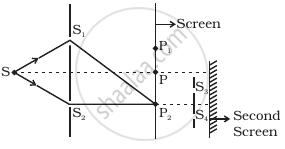Advertisements
Advertisements
Question
On the basis of Huygens' wave theory of light prove that velocity of light in a rarer medium is greater than velocity of light in a denser medium.
Solution

XY : plane refracting surface
AB : incident plane wavefront
B1R : refracted wavefront
AA1 , BB1 : incident rays
A1R , B1R1 : refracted rays
∠ AA1M = ∠ BB1M1 = ∠ i : angle of incidence
∠ RA1N = ∠ R1B1N1 = ∠ r : angle of refraction
- Let XY be the plane refracting surface separating two media rarer and denser of refractive indices μ1 and μ2 respectively.
- A plane wavefront AB is advancing obliquely towards XY from rarer medium. It is bounded by rays AA1 and BB1 which are incident rays.
- When 'A' reaches at 'A1' then 'B' will be at 'P' . It still has to cover distance PB1 to reach XY.
- According to Huygens' principle , secondary wavelets will originate from A1 and it will spread over a hemisphere in denser medium.
- All the rays between AA1 and BB1 will reach XY and spread over the hemispheres of increasing radii in denser medium. The surface of tangency of all such hemisphere is RB1 . This gives rise to refracted wavefront B1R in denser medium.
- A1R and B1R are refracted rays.
- Let c1 and c2 be the velocities of light in rarer and denser medium respectively.
- At any instant of time 't' , distance covered by incident wavelength from P to B1 = PB1 = c1t
Distance covered by secondary wave from A1 to R = A1R =c2t . - From above figure ,
∠ AA1M + ∠ MA1P = 90° .....(i) and
∠ MA1P + ∠ PA1B1 = 90° ...........(ii)
From equation (i) and (ii) , we have,
∠ AA1M = ∠ PA1B1 = 90° - Similarly ,
∠NA1R = ∠ N1B1R1 = r
We have,
∠ N1B1R1 + ∠ A1B1R = 90° .........(iii)
and
∠ N1B1R1 + ∠ A1B1R = 90° .........(iv)
From equations (iii) and (iv) , we have,
∠ N1B1R1 + ∠ A1B1R = r - In Δ A1PB1 ,
sin i = `"PB"_1/("A"_1"B"_1) = ("c"_1"t")/("A"_1"B"_1)` ........(v) - In Δ A1RB1 ,
sin r = `("A"_1"R")/("A"_1"B"_1) = ("c"_2"t")/("A"_1"B"_1)` ............(vi) - Dividing equation (v) bt (vi), we have
`("sin" "i")/("sin""r") = ((c_1t) / (A_1B_1))/((c_2t)/(A_1B_1))`
`therefore ("sin" "i")/("sin""r") = c_1/c_2` .....(vii)
Also `c_1/c_2 = mu_2/mu_1 = 1 mu_2` .....(viii)
where 1μ2 = R.I. of denser medium w.r.t rarer medium. - From above figure ,
∠ i > ∠ r
∴ sin i > sin r
∴ `("sin" "i")/("sin" "r") > 1`
`therefore mu_2/mu_1 > 1` .........(ix)
Since , `c_1/c_2 = mu_2/mu_1` ..........[From ix]
`therefore c_1/c_2 > 1`
`therefore c_1 > c_2`
Hence , velocity of light in rarer medium is greater than veocity in denser medium.
APPEARS IN
RELATED QUESTIONS
Explain the construction of plane wavefront using Huygens’ principle.
You have learnt in the text how Huygens’ principle leads to the laws of reflection and refraction. Use the same principle to deduce directly that a point object placed in front of a plane mirror produces a virtual image whose distance from the mirror is equal to the object distance from the mirror.
State Huygen's principle.
Use Huygens' principle to verify the laws of refraction.
Using Huygens’ principle, verify the laws of reflection at a plane surface.
Using this principle draw a diagram to show how a plane wave front incident at the interface of the two media gets refracted when it propagates from a rarer to a denser medium. Hence verify Snell's law of refraction.
When the width of the slit is made double the original width, how would this affect the size and intensity of the central diffraction band?
Huygens' principle of secondary wavelets may be used to
(a) find the velocity of light in vacuum
(b) explain the particle behaviour of light
(c) find the new position of a wavefront
(d) explain Snell's Law
Light waves travel in vacuum along the X-axis. Which of the following may represent the wave fronts?
With what type of source of light are cylindrical wave fronts associated?
Answer the following question.
Define the term wavefront. Using Huygen's wave theory, verify the law of reflection.
Define a wavefront. Using 'Huygens' principle, draw the shape of a refracted wavefront, when a plane wave is incident on a convex lens.
What is the geometrical shape of the wavefront for:
- Light diverging from a point source?
- The pattern of wavefront of the light from a distant star intercepted by earth?
What is the phase difference between any two points lying on the same?
The inverse square law of intensity is valid for a
Wavefront means
Figure shows a standard two slit arrangement with slits S1, S2, P1, P2 are the two minima points on either side of P (Figure). At P2 on the screen, there is a hole and behind P2 is a second 2-slit arrangement with slits S3, S4 and a second screen behind them.

For light diverging from a point source ______.
- the wavefront is spherical.
- the intensity decreases in proportion to the distance squared.
- the wavefront is parabolic.
- the intensity at the wavefront does not depend on the distance.
Is Huygen’s principle valid for longitudinal sound waves?
Two light beams of intensities in the ratio of 9 : 4 are allowed to interfere. The ratio of the intensity of maxima and minima ______.
What type of wavefronts are associated with a source infinity?
Using Huygen's wave theory of light, show that the angle of incidence is equal to the angle of reflection. Draw a neat and labelled diagram.
What type of wavefronts are associated with a point source of light?
Represent diagrammatically how the incident planar wavefronts of wavelength λ pass through an aperture of size d, when d is approximately equal to λ.
